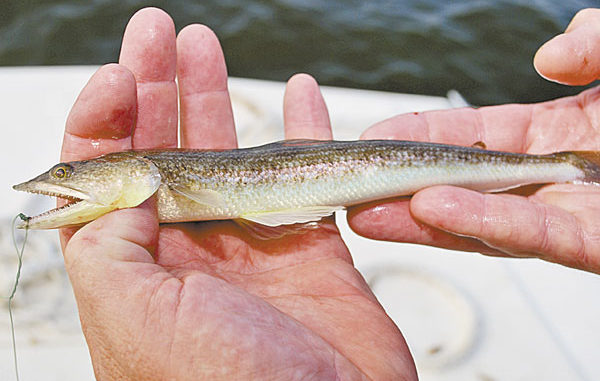
Most fish-identification books (except mine, of course) list the value of lizardfish to anglers as either a “nuisance” or “useless.” I happen to think that they are a pretty interesting critter. It could be the biologist in me.
The member of the lizardfish family most commonly encountered by fishermen is the inshore lizardfish, Synodus foetens. The first part of its scientific name, Synodus, translates from Greek as meaning “tooth meeting.” And indeed, teeth are what these fish are all about. They even have teeth on their tongues.
The meaning of the second part of their name, foetens, is easy to guess if one is familiar with the word “fetid,” sometimes spelled “foetid.” It has Latin roots and means “stinky.” After death, they deteriorate rapidly, and smell foul. Dead inshore lizardfish tossed on the bank are a common sight wherever bank fishermen fish in brackish waters.
Inshore speckled trout and redfish fishermen have a lot more interaction with this species than they realize. When you hear someone in the boat say, “They are just bumping my baits today. I don’t know why I can’t hook them,” the culprit producing those bumps is likely to be a lizardfish.
Anglers using natural baits, particularly shrimp on the bottom, are more likely to hook and land these oddities. Most give one look at the creature and try to get them off the hook without touching them.
Their looks are enough to be off-putting. The head is passively reptilian in appearance. It is almost identical to that of a lizard. Their gaping mouth is loaded with teeth, and their eyes look like alligator eyes.
Most peculiar of all, they are the stiffest fish in the sea. Their perfectly cylindrical bodies seem to be in a constant state of rigor mortis. They can be picked up by the base of the tail and their bodies will extend from the hand like a hammer handle.
Their unusual appearance does nothing to detract from their predatory ability, however. When lying on the bottom in hunting mode, they use their paired belly (ventral) fins to prop the forward part of their bodies up at an angle.
From this position, they dart both upwards and to the side to capture prey, as well as to escape larger predators. Their movements are so fast that they are almost invisible.
Inshore lizardfish can be found from the shallowest estuarine bays out to 600-foot depths offshore, although they are far more common in inshore habitats, hence the name. They live a solitary lifestyle, except when spawning.
Adults don’t seem choosy about bottom types, and can be found over sand, mud or oyster reefs and in grass beds. On sand bottoms they are known to partially bury themselves in the bottom to help camouflage themselves for ambush. One habitat they don’t seem to use is the high-energy beach surf zone.
Inshore lizardfish prey heavily on small fish, especially anchovies, which everything else in the sea seems to eat. They also eat large quantities of shrimp, squid and worms.
Adults seem to migrate offshore to depths of 100 feet or more to spawn. In the southern Gulf of Mexico, peak spawning activity takes place between March and June. Their eggs and larvae are free-floating in open waters. As currents carry them near estuaries, the juveniles drop out of the water column and become bottom-dwellers.
Seven other species of lizardfish live in the northern Gulf of Mexico. The only other species that uses shallow water, the sand diver, is also the only one that rivals the 18-inch maximum size of the inshore lizardfish. It has a prominent black spot on the gill cover near the top of the opening that the inshore lizardfish doesn’t have.
The other common lizardfish species is the offshore lizardfish. It is seldom found in waters shallower than 90 feet deep. It’s distinguishing feature is a prominent fleshy knob on the tip of its lower jaw. It grows to only 10 inches long.
Lizardfish are not known in Louisiana, or indeed in most of the United States, for their qualities as table fare. However, Charles S. Manooch III, author of the book Fisherman’s Guide: Fishes of the Southeastern United States, notes that small local markets for lizardfish have been developed in Florida, catering to the demands of Asian restaurants. Manooch says that they may be broiled or deep fried.
Various sources, including the Food and Agriculture Organization of the United Nations, state that members of the lizardfish family are of commercial importance in Southeast Asia. The same source also reports the flesh of the fish to be of good flavor but bony.
Jerald Horst is author of six books on fish and seafood, including the acclaimed Trout Masters: How Louisiana’s Best Anglers Catch the Lunkers. He is also a co-author of The Anglers Guide to Fishes of the Gulf of Mexico.


